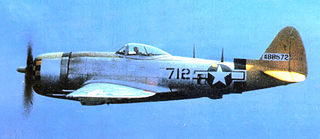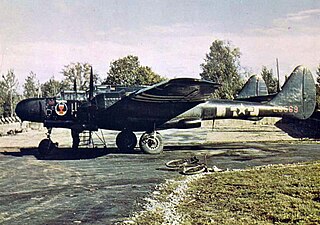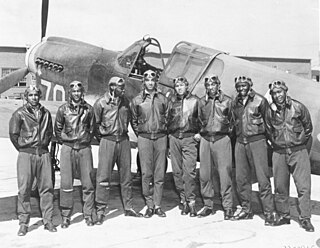The V Bomber Command is an inactive United States Army Air Forces unit. It was last assigned to Fifth Air Force, based at Irumagawa AB, Japan. It was inactivated on 31 May 1946.

The VIII Fighter Command was a United States Army Air Forces unit of command above the wings and below the numbered air force. Its primary mission was command of fighter operations within the Eighth Air Force. In the World War II European Theater, its primary mission was air superiority. Its last assignment was with the United States Air Forces in Europe at RAF Honington,

The 67th Cyberspace Operations Group is a unit of the 67th Cyberspace Wing. Headquartered on Kelly Field Annex's Security Hill, the group is an Air Force information operations unit.

The V Fighter Command is a disbanded United States Air Force headquarters. It was established as the 2nd Interceptor Command in June 1941, with responsibility for air defense of the northwest United States and training fighter units in its area of responsibility. Shortly after the attack on Pearl Harbor, the Army formed Western Defense Command, with responsibility for the entire Pacific coast. All air defense functions were transferred to 4th Interceptor Command, and the command was slated for transfer to the Southwest Pacific Theater as 5th Fighter Command.

The XIII Bomber Command was an inactive United States Army Air Forces formation. It was last assigned to Thirteenth Air Force, based at Clark Field, Luzon, Philippines. It was inactivated on 15 March 1946.

The XIII Fighter Command was a United States Army Air Forces formation. It was last assigned to Thirteenth Air Force, based at Manila, Luzon, Philippines. It was inactivated on 15 March 1946.

The IX Air Defense Command was a United States Army Air Forces formation. It was assigned throughout its time in combat to Ninth Air Force. Its final station was at Bad Neustadt an der Saale, Germany, where it was inactivated on 25 June 1946.

The IX Fighter Command was a United States Army Air Forces formation. Its last assignment was with the Ninth Air Force, based at Erlangen, Germany, wheret was inactivated on 16 November 1945.

The IX Tactical Air Command was a formation of the United States Army Air Forces. It fought in the European theater of World War II. Its last assignment was at Camp Shanks, New York, where it was inactivated on 25 October 1945.

The XIX Tactical Air Command is an inactive United States Air Force unit. The unit's last assignment was with the Ninth Air Force based at Biggs Field, Texas, where it was inactivated on 31 March 1946.

The 53rd Test and Evaluation Group is a group of the United States Air Force. It is a part of the 53rd Wing, and is headquartered at Nellis AFB, Nevada.

The III Fighter Command is an inactive United States Air Force unit. Its last assignment was at MacDill Field, Florida. It was inactivated on 8 April 1946.

The III Reconnaissance Command is a disbanded United States Army Air Forces unit. Its last assignment was with Third Air Force stationed at Rapid City Army Air Base, South Dakota, where it was inactivated on 8 April 1946. After transferring to the United States Air Force in September 1947, it was disbanded in October 1948.

The III Tactical Air Command was a United States Army Air Forces formation. Its last assignment was with Third Air Force stationed at Barksdale Field, Louisiana. It was disbanded on 24 October 1945. The command was established in 1941 as the 3rd Air Support Command. It was responsible for training tactical units and aircrews for the Army Air Forces, except for the period from August 1943 through March 1944, when it specialized in training reconnaissance units.
The II Air Support Command is an inactive United States Air Force unit. It was last assigned to Third Air Force at Biggs Field, Texas, as the II Tactical Air Division, where it was inactivated on 22 December 1945.

The I Tactical Air Division is an inactive United States Air Force unit. It was last assigned to Second Air Force, based at Biggs Field, Texas. It was inactivated on 22 December 1945.

The XII Tactical Air Command was a formation of the United States Army Air Forces. Its last assignment was with the United States Air Forces in Europe at Bad Kissingen, Germany, where it was inactivated on 10 November 1947.

The XXII Tactical Air Command is an inactive United States Air Force unit. Its last assignment was with Twelfth Air Force, at Pomigliano Airfield, Italy, where it was inactivated on 4 October 1945.

The 318th Cyberspace Operations Group is a United States Air Force information operations unit located at Joint Base San Antonio, Texas. The group was first activated during World War II as the 8th Photographic Reconnaissance Group. After training in the United States, the unit moved to the China-Burma-India Theater and engaged in hostilities until the end of the war. It returned to the United States in November 1945, and was inactivated at the port of embarkation.

The 24th Intelligence Squadron is an active United States Air Force unit stationed at Ramstein Air Base, Germany. The squadron was first activated as the 24th Observation Squadron during World War II. it conducted aerial reconnaissance training, until converting to the photographic mission as the 33d Photographic Reconnaissance Squadron. it deployed to the European Theater of Operations, where it conducted combat reconnaissance missions, earning a Distinguished Unit Citation and being cited in the Belgian Army Order of the Day on two occasions. It remained in Europe following V-E Day, becoming non operational in August 1945. Its ground echelon returned to the United States in the fall of 1945 and it was inactivated at the port of embarkation.



















